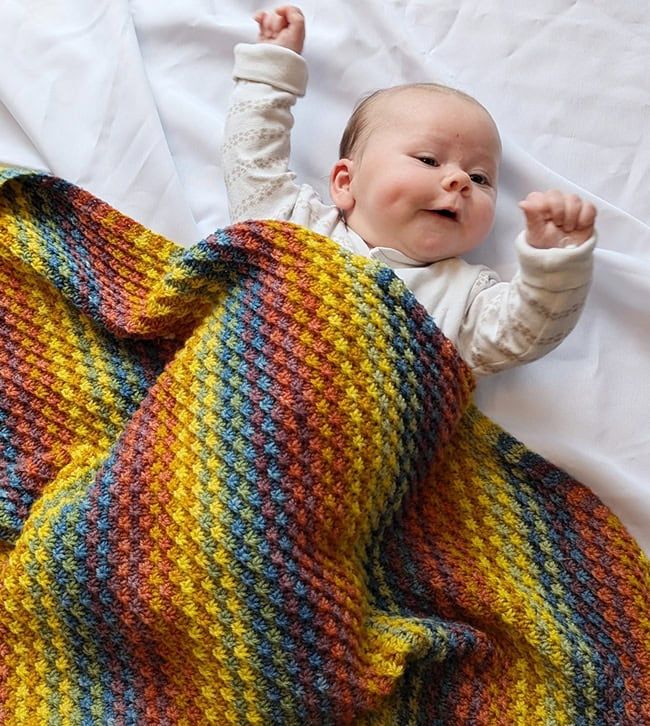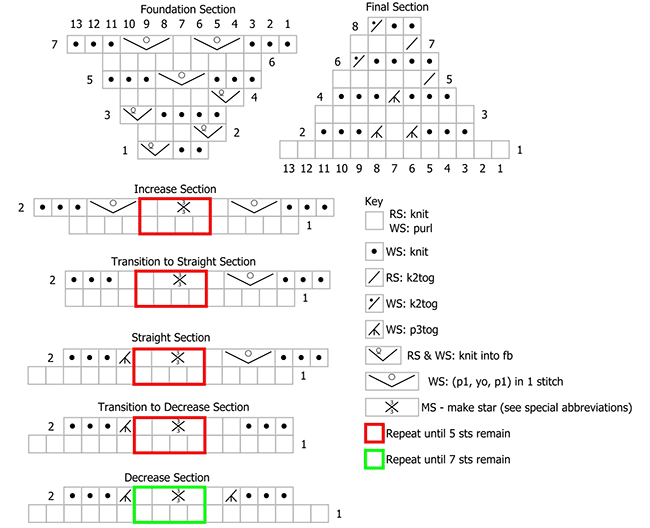Knitted Beautiful Baby Blanket
Knitting a beautiful baby blanket is such a heartwarming project that oozes love and care. The soft yarn gliding through your fingers, creating a cozy masterpiece for a precious little one, is simply delightful. The intricate stitches and soothing colors come together like a warm hug, guaranteeing that every naptime or cuddle session will be wrapped in handmade love. It's a wonderful way to show your crafty side while gifting something special to welcome a new bundle of joy into the world.

SIZE
One
Note: This pattern is infinitely customizable to make any size or shape of rectangle you like.
If you are going to make a different sized rectangle, it is vital that you leave enough yarn for the decrease section. I recommend weighing your work just before starting the straight section so that you know exactly how much yarn you will need for the decrease section. And round up a little, for safety's sake.
FINISHED MEASUREMENTS
Width: 32.5 inches/82.5cm
Length: 51.25 inches/130cm
MATERIALS
Yarn
Version photographed: World of Wool Santorini DK 100 superwash merino wool, 252 yds/230m per 100g skein, hand dyed by myself using sustainably collected or purchased plant materials;
Color A: red, dyed with Madder, 1 skein
Color B: orange, dyed with Madder and Onion skins, 1 skein
Color C: yellow, dyed with Birch leaves, 1 skein
Color D: green, dyed with Common Reed flowers, 1 skein
Color E: blue, dyed with Indigo, 1 skein
Color F: purple, dyed with Oakmoss lichen, 1 skein
Suggested widely available alternative yarns:
Stylecraft Special DK, 100% premium acrylic, 323 yds/295m per 100g ball;
Color A: 1010 Matador, 1 ball
Color B: 1711 Spice, 1 ball
Color C: 1081 Saffron, 1 ball
Color D: 1826 Kelly Green, 1 ball
Color E: 1003 Aster, 1 ball
Color F: 1061 Plum, 1 ball
OR
Drops Karisma 100% superwash merino wool; 55 yds/50m per 50g ball;
Color A: 18 Red, 3 balls
Color B: 11 Orange, 3 balls
Color C: 52 Dark Mustard, 3 balls
Color D: 45 Light Olive, 3 balls
Color E: 30 Light Denim Blue, 3 balls
Color F: 39 Dark Old Rose, 3 balls
OR
West Yorkshire Spinners Colour Lab DK, 100% wool, 246 yds/225m per 100g ball;
Color A: 0556 Crimson Red, 1 ball
Color B: 0476 Zesty Orange, 1 ball
Color C: 0229 Citrus Yellow, 1 ball
Color D: 0363 Bottle Green, 1 ball
Color E: 0364 Harbour Blue, 1 ball
Color F: 0717 Thistle Purple, 1 ball
Yarn Characteristics
The sample is made using a 3-ply DK weight yarn with a round profile and smooth surface. This pattern will work best in solid colors with 3 or more plies which will give good stitch definition and show the stars at their best.
Recommended needle size
[always use a needle size that gives you the gauge listed below - every knitter's gauge is unique]
US #8/5mm circular needle, 32 inches/80 cm or longer
Notions
Yarn needle for sewing in ends
GAUGE
24 sts/28 rows = 4 inches/10 cm in pattern stitch.
Note: The recommended needle size for the suggested yarns is US6/4mm giving a suggested gauge of 21-22 stitches and 28-30 rows to 4 inches/10cm. This pattern is worked on larger needles than recommended on the ball band.
Gauge is not critical in this project, but working at a different gauge will result in a different finished item and will change yardage requirements. If your gauge is looser, you will need extra yarn. The pattern instructions include advice for making sure you have enough yarn as you work the blanket.
PATTERN NOTES
Construction method: This blanket is worked diagonally from one corner to the opposite corner. Starting with a small cast-on, and working flat in rows, increases are worked until the desired width is reached, then decreases are worked at one edge along with increases at the other edge until the desired length is reached, then decreases are worked at both edges until only a few stitches remain. The pattern is written for 6 colors, forming a rainbow. These are worked in a sequence of 18 stripes, which are repeated 10 times in all over the entire blanket, so that you use an equal quantity of each color.
Pattern stitches are worked on WS rows only.
Colors change on every RS row so that the stars show up well.
MS (make star): Purl next 3 sts together, but do not remove loops from your left-hand needle. Make a yarnover – by taking yarn over top of needle from front to back, then forward under the needle tip – then purl the same 3 sts again.
CHARTS

Directions:
Using Color A, CO 3 sts using long tail or your preferred method.
Foundation Section
Work from chart or written instructions as you prefer.
Rows 1-4: Kfb, k to end. 1 st increased.
Row 5 [WS]: K3, (p1, yo, p1) in next stitch, k3. 9 sts.
Row 6 [RS]: Knit.
Row 7: K3, (p1, yo, p1) in next stitch, p1, (p1, yo, p1) in next stitch, k3. 13 sts.
Increase section
When working this section, you add 4 sts (one pattern repeat) on each WS row. Start with color A and change color on every RS row. I advise carrying the unused color up the edge of the work for no more than two rows. Take care not to pull yarn too tightly at the start of rows when doing this.
Work in the following color sequence of 18 stripes (2 rows of each color):
A B A, B C B, C D C, D E D, E F E, F A F. Then start again at the beginning of the sequence. Work the color sequence throughout.
Work from chart or written instructions as you prefer.
Row 1 [RS]: Knit.
Row 2 [WS]: K3, (p1, yo, p1) in next stitch, [p1, MS] to last 5 sts, p1, (p1, yo, p1) in next stitch, k3. 4 sts increased.
Work these two rows 68 times in total. 285 sts. You will be partway through the color sequence.
Transition to straight section:
Work from chart or written instructions as you prefer.
Row 1 [RS]: Knit.
Row 2 [WS]: K3, p1, [p1, MS] to last 5 sts, p1, (p1, yo, p1) in next stitch, k3. 287 sts.
Straight Section
Note: If you are not working the blanket exactly as described, weigh your work at this point so that you can ensure you leave plenty of yarn for working the decrease section.
In this section you work decreases at the start of WS rows and continue with increases at the end of the rows. The stitch count remains the same. Continue stripe sequence as established.
Work from chart or written instructions as you prefer.
Row 1 [RS]: Knit.
Row 2 [WS]: K3, p3tog, [p1, MS] to last 5 sts, p1, (p1, yo, p1) in next stitch, k3.
Work these two rows 21 times in total. You are now halfway through your blanket if working as described. You will have worked 5 full repeats of the color sequence of 18 stripes.
Weigh your work. If you have used less than half of your yarn, work the two rows of the straight section another 21 times.
If you have used more than half of your yarn, and you are following the 18-stripe sequence, you will need to shorten the straight section by one full sequence of 18 stripes; work the two rows of the straight section another 3 times. Do not be tempted to work extra stripes here, as you may run out of some colors before you finish the blanket. Your blanket will be a little shorter than planned, but it will still be a nicely balanced rectangle.
Transition to Decrease Section:
Work from chart or written instructions as you prefer.
Row 1 [RS]: Knit.
Row 2 [WS]: K3, p3tog, [p1, MS] to last 5 sts, p2, k3. 285 sts.
Decrease Section
In this section, you remove one pattern repeat in each WS row by working decreases at both ends of the row.
Work from chart or written instructions as you prefer.
Row 1 [RS]: Knit.
Row 2 [WS]: K3, p3tog, [p1, MS] to last 7 sts, p1, p3tog, k3. 4 sts decreased.
Maintaining stripe sequence as before, work these 2 rows 68 times in total, until 13 sts remain. You will work the last 2 of these rows in color F, in the last stripe of the sequence.
Final section
Continuing with color F, work the last few rows as follows:
Work from chart or written instructions as you prefer.
Row 1 [RS]: Knit.
Row 2 [WS]: K3, p3tog, p1, p3tog, k3. 9 sts.
Row 3: Knit.
Row 4: K3, p3tog, k3. 7 sts.
Rows 5-8: K2tog, k to end of row. 1 st decreased.
Break yarn, pass yarn end through remaining 3 sts and fasten off.
FINISHING
Weave in all ends neatly and securely.
Soak in lukewarm water with a drop of washing up liquid or wooly wash for 20-30 minutes, or wash as you would intend to wash the blanket if it were dirty. How you do this will depend on the yarn you are using. Roll in towels, or short spin in a machine to remove excess water. Pull gently into shape on a flat surface and allow to dry completely. Do not pin or stretch.